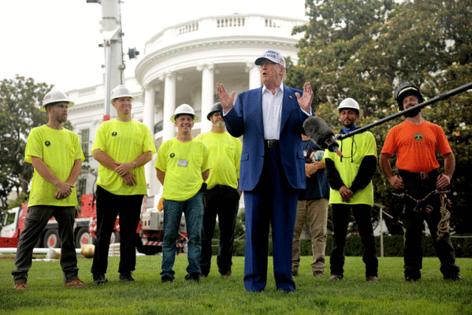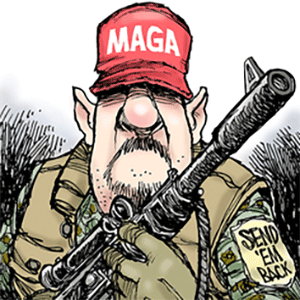On Iran strikes messaging, Trump aides opt to run it up the flagpole
Published in News & Features
WASHINGTON — As President Donald Trump exited the East Room last Thursday following an impromptu midday news conference, he dismissed a reporter’s question about what it would take to get Iranian officials back to the negotiating table.
Six days later, amid the president’s rapid shift from a diplomatic to a hawkish approach to Iran’s nuclear arms program, the Trump communications operation is waving off questions about the commander in chief’s consideration of joining Israeli strikes on Iran. The uncharacteristic communications strategy has given oxygen to Democrats to raise warnings about direct American involvement in the conflict.
On Thursday, a CQ Roll Call reporter, positioned by the double doors that lead into the East Room, had questioned Trump about Iran over the applause of invited guests at a bill signing ceremony. The president considered the question for a couple of seconds before declining to answer.
Nine hours later, it became apparent why, when Israel launched strikes on targets inside Iran as Trump mingled with another set of invited guests at the annual White House Congressional Picnic. Officials from both sides have since confirmed that Israel’s government had, by that point, informed the White House of its strike plans.
After Trump on Monday evening cut short his time at a G7 summit in the Canadian Rockies, ostensibly to get back to the White House to oversee the Israel-Iran conflict, his statements during an Air Force One gaggle raised several questions. So did his social media posts once he was back in Washington.
Trump mocked a reporter Wednesday morning for asking, after the president had spoken about a flagpole he ordered installed on the White House South Lawn, if he was moving closer toward ordering U.S. military strikes in Iran.
“You don’t seriously think I’m going to answer that question: ‘Will you strike the Iranian nuclear component, and what time exactly, sir? Sir, would you strike it? Would you please inform us so we can be there and watch?’” said Trump, wearing a white “Make America Great Again” ball cap and no tie and surrounded by construction workers.
The president also kept a veil of mystery around his considerations one day after he and his national security team spent nearly 90 minutes in the Situation Room discussing possible American involvement in Israeli’s aerial bombardment of targets inside the Islamic republic.
“You don’t know that I’m going to even do it,” Trump said Wednesday of possible American strikes. “I may do it. I may not do it. I mean, nobody knows what I’m going to do.”
“I can tell you this, that Iran’s got a lot of trouble, and they want to negotiate. And I said, ‘Why didn’t you negotiate with me before all this death and destruction,'” he added. “‘Why didn’t you negotiate with me two weeks ago? You could have done fine.’”
‘Make a deal’
The U.S. commander in chief appeared to suggest Wednesday that the conflict could end before he has to decide on joining the Israeli effort.
Asked if he could order U.S. strikes on Iranian targets in the next week or so, Trump replied: “I don’t know how much longer it’s going to go on. They’re totally defenseless. They have no air defense whatsoever. … We’ve totally captured the air.”
Trump used a Tuesday social media post to warn Iranian Supreme Leader Ayatollah Ali Khamenei that U.S. and Israeli officials know his location and that he was an “easy target.” But by Wednesday morning, he had made a diplomatic pivot, declaring, “Iran wants to make a deal.”
His roughly 20 minutes in front of the press corps on Wednesday raised more questions than answers about his plans. It came after reporters on Tuesday at the White House and State Department had received few answers from the president’s communications team.
At several points Tuesday, reporters were met by empty chairs and closed doors in the White House press office — a throwback to the first Trump term, when the administration’s rhetorical clashes with Iran, that saw him threaten Tehran but never order air strikes, were often followed by a skeleton crew of spokespersons fielding questions.
A senior White House official made clear on Tuesday that Trump’s White House and National Security Council communications teams would not answer a list of questions a CQ Roll Call reporter had submitted via email.
Hours later, State Department chief spokesperson Tammy Bruce kicked off a briefing by informing reporters she likely would not answer their questions about Iran.
“There [are] always things that I can’t say to you, and yet we have a long back-and-forth. Sometimes we have a little bit of a debate. I won’t engage in that today,” she said. “My responses will be perhaps a bit quicker than usual. … There will be less than I can answer for you because of the circumstances that we’re dealing with around the world.”
‘Singular guiding hand’
The administration’s chief communicator on Iran would be Trump himself, Bruce made clear.
“I think that we can take his word for his word, but I’m not going to speculate on, in a larger sense, what that would mean,” she said when asked if the president was considering striking only nuclear facilities or seeking a regime change in Iran too. “That is up to the president. He is the singular guiding hand about what will be occurring from this point forward, as he has been. And I think that that dynamic is pretty clear.”
As Trump aides appear to bet big that their boss — and the boss alone — can effectively handle both the strategy and the messaging, Trump’s Wednesday Q&A session provided few answers and little clarity on his thinking and any potential plans.
There was also no daily press briefing Tuesday nor one scheduled for Wednesday. Bruce was also not scheduled to brief reporters on Wednesday. As the Trump communications machine has gone silent, some influential Democrats have taken to warning against direct U.S. involvement in the Middle East conflict and explaining the many complexities that would face American military personnel.
“The fact is that to go after their nuclear capability, you’ve got to be able to go after these deeply buried facilities at Fordo that can only be attacked with bunker-busting weapons that the United States has, and be delivered by a B-2 bomber,” Leon Panetta, who was Defense secretary and CIA director under Barack Obama, told CNN this week.
“So to totally be able to wipe out their nuclear capability is just not going to happen if it’s left to Israel on their own,” the former California congressman said. “And with regards to regime change, I think the problem there is that it isn’t that easy to achieve in Iran.”
“You can undermine their command structure. You can go after their nuclear scientists. But the fact is, even if you go after Khamenei, there are going to be other hard-liners that will take their place,” he added. “If [Israel is] trying to weaken Iran, that’s an achievable goal. Beyond that, I think it’s going to be difficult.”
Also difficult has been spotting any consistency in Trump’s messaging. On Wednesday morning, he was, in a single train of thought, praising the Iranian people, verbally jabbing at the press corps and returning to his long-held stance that all wars are “stupid.”
“I know a lot of people from Iran, from New York, from Washington, mostly from New York. They’re incredible people. They’re smart, they’re energetic, they can be difficult — but so can you,” he said to a reporter. “They’re great people, smart people, and those people are getting the hell beat out of them now, and it’s really a shame. It’s so stupid. … It’s another one. Russia, Ukraine is so stupid.”
Khamenei, for his part, appears to be in agreement with Trump’s assessment of his countrymen.
“They should make threats against those who are afraid of being threatened,” the supreme leader said on social media. “The Iranian nation isn’t frightened by such threats.”
©2025 CQ-Roll Call, Inc., All Rights Reserved. Visit cqrollcall.com. Distributed by Tribune Content Agency, LLC.







Comments